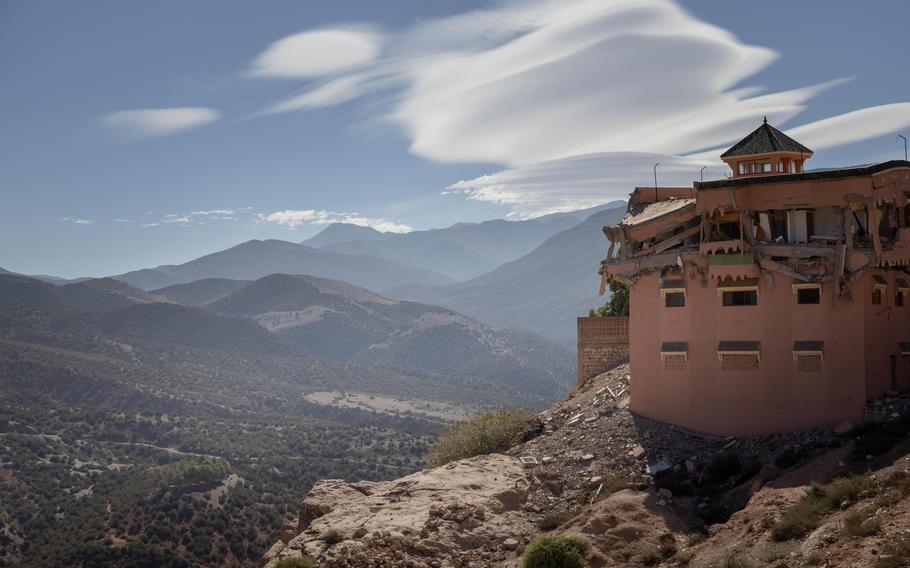
A badly destroyed cafe on the edge of a cliff in Moulay Brahim, Morocco on Sept. 11, 2023. (Sima Diab for The Washington Post)
Lightning bolts. A strange glow. Unusual flashes. Social media users reported odd lights in the sky near the time of Friday’s Morocco earthquake, which has taken more than 2,600 lives and injured thousands more.
While verifying the social media posts is difficult, scientists say earthquakes can produce various light phenomena in our atmosphere — signaling electric changes beneath the surface.
“The [Morocco] earthquake happened at nighttime,” said geophysicist Friedemann Freund. “The condition for earthquake lights to be seen by people and maybe even recorded by cameras would be relatively high.”
Several different light phenomena can be associated with earthquakes. Lightning is common, although it’s not your typical bolts during a thunderstorm. Earthquake lightning travels from ground to cloud, activated by electric charges associated with seismic activity within the earth. Other lights are also clearly associated with the artificial human-made lighting sources, such as electric poles or lamps.
But the “earthquake lights” that Friedemann is referring to are generated by an earthquake’s plate tectonic movement. They can appear as steady glows, balls of light, streamers or sheet lightning, according to the United States Geological Survey.
Friedemann explains that our planet is electrically conductive: When we plug into a wall, we ground those electric currents to Earth. During an earthquake, seismic or tectonic forces deform rocks and minerals in Earth’s crust, which allow electric currents to flow. These electric charges accumulate so much on Earth’s surface and eventually produce electric discharges — positively charged particles in the rocks attract negatively charged particles in Earth’s uppermost atmosphere. They can produce light overhead.
“If it was at night, it would be so bright that you can read the newspaper,” said Friedemann, who has previous published studies on earthquakes and earthquake lights. The color of the light depends on the type of excited atom in the atmosphere. Oxygen molecules could give a reddish or greenish light, but a mixture would produce a bright yellow light.
As electric charges are changing on the surface and in the air, Friedemann said people and animals can also sometimes get headaches — explaining some odd animal behavior right before an earthquake occurs. People could also see their hair stand up or feel a tickling feeling in their skin.
Lab experiments confirm voltage jumps when materials are put under pressure and crack, much like during an earthquake.
“If these earthquake lights happen, then this is an indication that stresses are building up, which would possibly lead to a mechanical phenomenon that we call an earthquake,” said Friedemann, who worked at NASA for 30 years and is now a senior research scientist at the SETI Institute.
But he added, “the connection is not totally guaranteed.”
Some geophysicists debate whether earthquake lights are actually linked to seismic activity or have a different explanation, such as sparking an electrical system. Seismologist John Ebel said he thinks earthquake lights are real because he has read reports from the 1700s — before electrical systems were in place.
Ebel said most earthquakes do not have reports of earthquake lights, but that could have several explanations. For one, he said a lot of earthquakes happen during the day, so people likely wouldn’t see the dim lights. Also, many earthquakes are centered from deep underground, but no lights have been reported with those either.
But studying when earthquake lights occur in relation to the tremble could help researchers better anticipate these fatal events. Most reports are given at the time of an earthquake — people wake up, see a flash, and the earth is shaking. If there were documentation that earthquake lights occurred before the event, then researchers could set up instrumentation near major fault lines to look for them as a warning sign.
“We have no direct way to measure the pulses within the Earth,” said Ebel, a professor of geophysics at Boston College. “If we could find some phenomenon that gives us information about the pressure build up in the Earth before the earthquake, that may help us to predict earthquakes.”